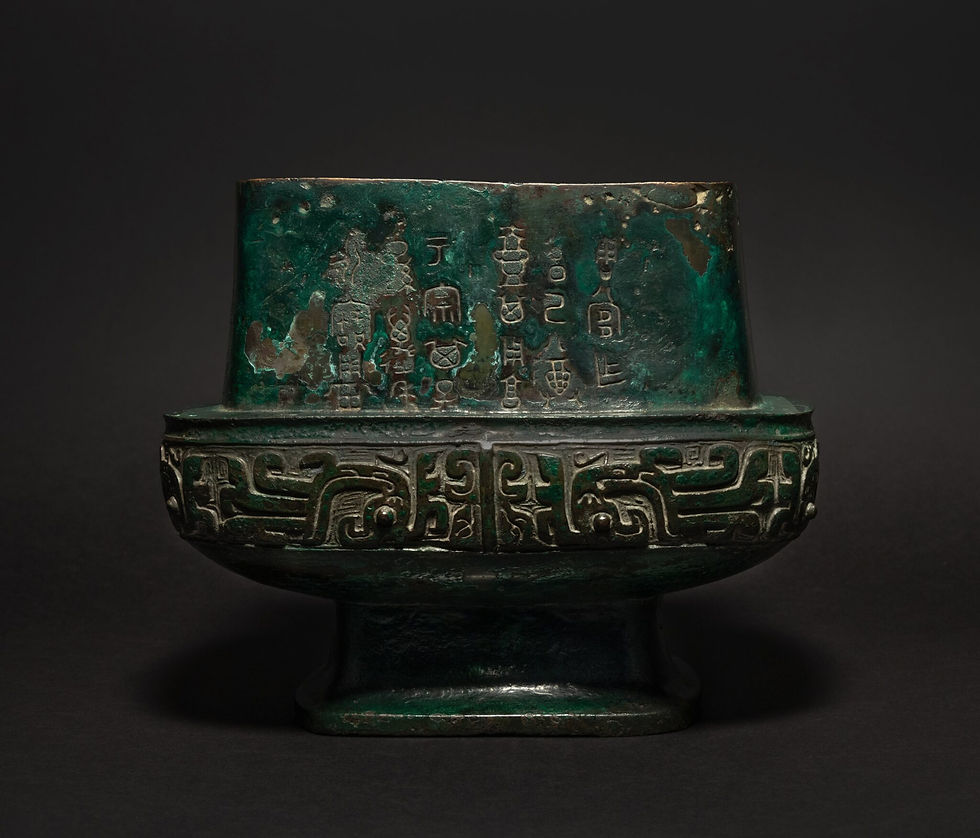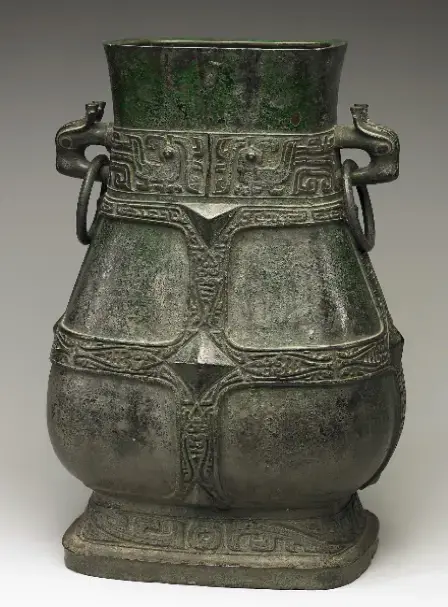紐約蘇富比 2024年9月18日 / 拍品33號
估價:3,000,000 - 5,000,000 USD
450萬美金,現場女士落槌,含佣金540萬美金,合人民幣約4000萬元。
皇家氣勢,同為乾隆至愛的倪瓚款獅子林圖中曾戲言「非王蒙所能夢見」,收入《石渠寶笈》。這件「周㗬壺」來源清晰,入《西清古鑑》,此般氣場和西周的銘文,加上清高宗的加持,應非普通青銅藏家所能奢想。
壺銘:
周㗬作公日己尊壺 其用享於宗 其孫孫子子萬年永寶用 周
蓋銘:
周㗬作公日己尊壺 其用享於宗 其子子孫孫萬年永寶用 周
整體品相極佳,見典型清代皮殼。壺身一側見一道約6公分裂紋經修。蓋為本品對壺(現藏台北故宮博物院)之蓋,故與本壺壺身蓋合時略見縫隙。整體見正常年久痕跡及輕微鑄造瑕疵。
出處
清高宗 愛新覺羅弘曆 收藏
清宮舊藏
周慶雲(1864-1933)收藏
著錄
梁詩正等,《西清古鑑》,卷19,1755年,頁14(器銘及線描)
王傑等,《西清續鑒甲編》,卷5,1793年,頁22(蓋銘及線描)
阮元,《積古齋鐘鼎彝器款識》,卷5,1804年,頁11(蓋銘)
孫詒讓,《古籀拾遺》,卷中,1872年,頁14至15(論及)
吳式芬,《攗古錄金文》,卷二之三,1895年,頁6(蓋銘)
劉心源,《奇觚室吉金文述》,卷18,1902年,頁12(蓋銘)
盛昱,《鬱華閣金文》,手稿本,十九世紀末/二十世紀初,頁276(器銘)
鄒安,《周金文存》,卷五,1916年,頁45(蓋銘)
羅振玉,《貞松堂集古遺文補遺》,卷上,1931年,頁39(器銘)
劉承干,《希古樓金石萃編》,卷5,1933年,頁6(器銘)
于省吾,《雙劍誃吉金文選》,卷下二,1933年,頁7(論及)
劉體智,《小校經閣金文拓本》,卷4,1935年,頁88(蓋銘)
羅振玉,《三代吉金文存》,卷12,1937年,頁20(器及蓋銘)
楊樹達,《積微居古文說》,1952年,頁94(論及)
巴納及張光裕,《中日歐美澳紐所見所拓所摹金文匯編》,台北,1978年,編號277(蓋銘)
嚴一萍,《金文總集》,1983年,編號5766(蓋銘及線描)及5767(器銘及線描)
邱修德,《商周金文集成》,1983年,編號6413/6414
中國社會科學院考古研究所編,《殷周金文集成》,卷6,北京,1984年,編號09690(蓋銘)及09691(器銘)
中國社會科學院考古研究所編,《殷周金文集成釋文》,卷5,香港,2001年,編號9690(蓋銘)及9691(器銘)
吳鎮峰,《商周青銅器銘文暨圖像集成》,卷22,上海,2012年,編號12392(器圖及銘)及12393(蓋銘)
董珊,〈試論殷墟卜辭之“周”為金文中的妘姓之琱〉,《中國國家博物館館刊》,期7,北京,2013年,頁52(論及)
黃明磊,〈略論中國早期國家階段族群的遷徙現象及其影響——以妘姓族群為例的考察〉,《西北民族論叢》,輯21,西安,2020年,頁9(記錄)
圖錄說明
周㗬壺,清宮之舊藏,中國高古璀璨文明之代表,古韻幽幽,世之瑰寶。本壺尺寸碩大,造型雄偉,巍然聳立,鑄工卓絕,莊重威嚴,通身鏽色純熟,歷千載往昔,獨蘊其中。其紋飾繁複,層次分明,工藝精湛,設計絕巧,不僅可供實用,亦彰顯其物主當時極高的社會地位。器上所鑄長銘,經歷代皇家學者及金石學家詳細記錄研究,更體現了本壺在金石界的分量之重、影響之廣。
周㗬壺傳承極佳,曾為乾隆皇帝御藏,珍存於紫禁城内,為內府所藏吉金重器,足見其重要的歷史文化價值。周㗬壺世上僅兩件,屬一對,同銘,除本壺外另一件現存於台北國立故宮博物院,亦屬清宮舊藏,今壺蓋已失(圖一),載於《故宮西周金文錄》,2012年,頁122,編號74。
圖一
乾隆十四年,皇帝命翰林院學士梁詩正、蔣溥及汪由敦等開始著手編纂《西清古鑑》,記錄清宮廷所藏古青銅器,六年後成書,共四十卷,乾隆二十年刻印。此書編排摹仿宋金石著作《博古圖》體例,附繪圖、簡述、記高度重量等,並對銘文加以考證。全書收錄一千五百多件御藏青銅器。此後,乾隆帝又詔命續編三部,集成四集,今合稱「西清四鑑」。此套皇家御書為古青銅器研究之重要書籍,其中所錄器物,因屬宮廷御藏而倍受歷代金石藏家極致推崇,但此「四鑑」所錄青銅器極少見於除北京及台北故宮所藏之外,屬於私人收藏者則更可謂是鳳毛麟角,極為罕見。
本壺器身及其銘文錄於《西清古鑑》(圖二),而壺蓋及蓋銘則與現存台北故宮之壺的壺身同錄於《西清續鑑甲編》之中(圖三)。
若以《西清》為據,本壺蓋於乾隆年間藏於內府之時,曾與現藏台北之壺所配。換言之,現藏台北故宮那件無蓋周㗬壺的壺蓋即為本次上拍之壺蓋。學者吳鎮烽推測,兩件壺的壺蓋或於流出清宮時配錯(見《商周青銅器銘文暨圖像集成》,卷22,上海,2012年,編號12392)。另一件壺蓋今已不知所踪,據上世紀初出版的一些金石文獻記載,如《周金文存》,卷五,1916年,頁45所錄拓本附印記「筱農所藏」,可知所遺壺蓋在流出宮外後曾進入過金石學家丁彥臣(號筱農)的收藏。周㗬壺作為清宮藏金,被收錄於兩集《西清》之中,足見當時乾隆皇帝以及一眾宮廷學者對其的珍視及重之。
周㗬壺除了其極為顯赫的皇家身份之外,其銘文同樣也尤為重要。周㗬壺器身內口處及壺蓋蓋唇處各鑄有二十四字銘文:
壺銘
周㗬作公日己尊壺 其用享於宗 其孫孫子子萬年永寶用 周
蓋銘
周㗬作公日己尊壺 其用享於宗 其子子孫孫萬年永寶用 周
據以上銘文可知,壺主名為周㗬。學者楊樹達認為銘文中之「公」字,當謂父也(見《積微居古文說》,1952年,頁94)。故銘文記周㗬為其父日己做此尊壺,用饗於宗廟,供其子孫後代萬年永寶之。銘文最末之字為族徽,表明周㗬所屬族氏。據王恩田研究,此族徽可解為「周」字(見《古文字研究》,2004年,卷25,頁29-35)。
周㗬之「周」並非是建立了周王朝的姬姓之周。據張懋鎔研究,商代貴族有在青銅器銘文中加入日名及族徽的習俗,而周人則無此慣例(見〈周人不用族徽說〉,《古文字與青銅器論集》,北京,2002年,頁223-230)。本壺銘中既有日名亦有族徽,故此可證周㗬所屬的周族並非姬姓之周,周㗬則應為商人之後。
董珊通過研究一組相關甲骨文及高古青銅器的銘文,考證出了此一周族的姓屬及源考(見〈試論殷墟卜辭之「周」爲金文中的妘姓之琱族〉,《中國國家博物館館刊》 ,期7,北京,2013年,頁48-63)。董珊認為此一支周族為妘姓,是商代古部族之一,曾居於周原(圖四),古公亶父遷岐山之後,此妘姓周族仍居舊地,與姬姓周人共存。後武王興周滅商,於牧野一戰擊敗商紂而建立西周王朝,此後妘姓周族仍然活躍於歷史的舞台,本壺銘文即為最好的證據,由此銘可知,西周時期的妘姓周族族人不僅可以享受與姬姓周人一樣的貴族特權,可以鑄金以祭祀先祖先宗,並且還得以保留其從商代傳承下來的記銘習俗,慣用日名及族徽。
存世可見一小組青銅器,皆署相同族徽,可知為同族之器。見周棘生簋,李芝齡、潘祖蔭舊藏,載於嚴一萍,《金文總集》,1983年,編號2519;父丁簋,出處同上,編號2477;倗生簋一組,載於中國社會科學院考古研究所編,《殷周金文集成》,北京,1984年,編號04262-04265;周父己爵,波士頓美術館藏,錄羅振玉,《三代吉金文存》,卷16,1937 年,頁15;及周乎卣,台北國立故宮博物院藏,圖載容庚,《商州彜器通考》,卷 II,北平,1941 年,圖版665。
幾個世紀以來,周㗬壺及其銘文歷經過多位著名金石學者大家的研究。1804年,清代著名學者阮元(圖五)曾於其重要金石著作《積古齋鐘鼎彝器款識》(圖六)中收錄周㗬壺銘,雖阮氏未能成功釋讀全部銘文内容,但其影響卻極爲深遠。
清代學者孫詒讓,亦曾深入研究本器銘文,並且首次正確釋出了銘文第二字為「㗬」,自此本壺改稱為「周㗬壺」,取代了自《西清》以來的舊稱「周宜壺」。1916年,鄒安在其著作《周金文存》中記錄周㗬壺兩件壺蓋的銘文拓本,其一附印「筱農所藏」,證其為丁彥臣所藏,前文已述,而另一蓋銘拓本(即為本壺蓋銘)則附有「夢坡寶藏」印記。夢坡為浙江吳興富商兼藏家周慶雲(1866-1934年)的號,故證本壺壺蓋曾為周氏所藏。1937年,羅振玉在其金石巨作《三代吉金文存》中完整收錄了兩件周㗬壺器身及蓋身的銘文拓本,共四篇,羅氏並根據《西清》的原始記錄,將兩壺器銘及蓋銘還原配對。自清乾隆年間《西清》端始,對周㗬壺的著錄研究數不勝數,可見此壺在金石界的顯赫地位,實可謂價值無量。
The Zhou Zha Hu, a well-known ancient relic once treasured in the Qing imperial collection, stands as a monumental testament to the artistry and sophistication of a glorious age in ancient China. Towering with an imposing presence, the vessel is majestically cast, embodying both commanding power and graceful elegance, with a deep, mature patina that whispers of centuries past. Its intricate design and craftsmanship reflect the ceremonial and ritualistic practices of the time, serving not only as a functional object but also as a medium for conveying the social and political prestige of its owner. Its long inscription of historical importance has been documented and studied by generations of imperial scholars and collectors, further solidifying its status as an esteemed masterwork of archaic bronze from the dawn of China's civilization.
The Zhou Zha Hu's provenance is distinguished, having been cherished by the Qianlong Emperor (r. 1736-1795) and housed within the Forbidden City. This imperial lineage not only underscores its significant historical and cultural value but also elevates its prominent status as it once passed through the hands of one of China's most illustrious emperors. Only one other hu of this design and Zhou Zha inscription is known – the companion piece to the present hu – and is preserved, absent its cover, in the Palace Museum, Taipei (Fig. 1), published in Gugong xizhou jinwen lu / Catalogue of Western Chou Bronze Inscription in the National Palace Museum, Taipei, 2012, p. 122, cat. no. 74.
In 1749, the Qianlong Emperor commissioned a group of scholars from the Hanlin Academy, led by Liang Shizheng (1697-1763), Jiang Pu (1708-1761), and Wang Youdun (1692-1758), to compile an illustrated catalogue of archaic bronzes in the imperial collection. The project took six years to complete, culminating in 1755 with the printing of the forty-volume Xiqing gujian [Catalogue of Antiques in the Xiqing Pavilion]. This imperial catalogue, following the tradition of earlier antiquities catalogues such as the Song dynasty Bogutu [Illustrations of Broad Antiquity], provided illustrations of each object along with brief descriptions, measurements and background research. The Xiqing gujian includes details of over 1,500 bronzes, which constituted only part of the bronze collection in the Forbidden City. The Qianlong Emperor subsequently decreed three sequels to be completed by another group of imperial scholars. This set of four imperial catalogues is regarded today as one of the most important treatments of ancient bronzes ever written and the works listed within have long been highly sought-after by collectors for their royal lineage. Very few vessels preserved outside of the two Palace Museums, however, can be identified as having been recorded in these imperial catalogues, all the more so of those remaining in private hands.
The vessel of the present hu is recorded in Xiqing gujian (Fig. 2). Its cover, on the other hand, is included in the first sequel of the book, Xiqing xujian jiabian [Supplement A to Xiqing gujian] (Fig. 3), matched with the vessel that is currently in the collection of the National Palace Museum. This suggests that the present cover may well have been originally placed on top of the vessel now housed in Taipei when they were in the Imperial Palace. The inclusion of the Zhou Zha Hu in these prestigious imperial catalogues signifies its importance and the high regard in which it was held by the Qing court.
Wu Zhenfeng also speculates that the covers of the hu were switched after they left the imperial collection (see Shangzhou qingtongqi mingwen ji tuxiang jicheng [Compendium of inscriptions and images of bronzes from Shang and Zhou dynasties], vol. 22, Shanghai, 2012, no. 12392). The whereabouts of the other cover, however, remains a mystery. Traces of evidence from compilations of antique bronzes published in the beginning of the last century indicate it was once in the collection of Ding Yanchen (1829-1873), known by the art name (hao) Xiaonong but, beyond that, the trail appears to run dry. See, for example, an ink rubbing of the cover's inscription published in Zou An, Zhou jinwen cun [Surviving writings from the Zhou dynasty], vol. 5, 1916, p. 45, where it was accompanied by a seal reading Xiaonong suocang (collected by Xiaonong).
In addition to its important imperial association, the Zhou Zha Hu is also remarkable for its long inscription. The twenty-four-character inscription in ancient seal script on the vessel and cover indicates the hu belonged to Zhou Zha, who commissioned this bronze for Gong Ri Ji. According to Yang Shuda, the character gong can be referred to as 'father' in ancient China (see Yang Shuda, Jiweiju jinwen shuo [On the bronze inscriptions in Jiweiju], 1952, p. 94). The inscription notes how Zhou Zha made the hu for his father Ri Ji to be used during rituals and ceremonies in their ancestral hall, to be treasured eternally for ten-thousand years by his sons and grandsons. The last character of the inscription is a clan pictogram, identifying the family to which Zhou Zha belonged. Based on the study by Wang Entian, this pictogram can be interpreted as zhou (see Guwenzi yanjiu [Study of ancient characters], vol. 25, Beijing, 2004, pp 29-35).
This Zhou clan, however, is not to be confused with the Zhou that established an empire over the land of China by defeating the last king of the Shang dynasty. Indeed, the inclusion of a clan pictogram in the inscription of the present hu suggests that the owner of the vessel, Zhou Zha, was a descendant of the Shang rather than a native of Zhou. As Zhang Maorong explains, aristocrats from the Shang dynasty had the tradition of including clan pictograms in bronze inscriptions, and this tradition was not practiced by the Zhou people of the new empire (see 'Zhouren buyong zuhui shuo [Zhou residents do not use clan pictogram],' Guwenzi yu qingtongqi lunji [Collection of essays on Chinese ancient characters and archaic bronzes], Beijing, 2002, pp 223-230).
Dong Shan has conducted a study on the origin of this clan based on a group of related oracle bone inscriptions and archaic bronze inscriptions (see 'Shilun Yinxu buci zhi 'zhou' wei jinwen zhong de yunxing zhi zhou [An Attempt to Discuss that the 'Zhou' in Oracle Bone Inscriptions from Yinxu is the 'Zhou' of the Yun Family in Archaic Bronze Inscriptions]', Zhongguo guojia bowuguan guankan / Journal of National Museum of China, no. 7, Beijing, 2013, pp 48-63). The author believes that this Zhou clan, with the xing (family name) of Yun, was one of the ancient tribes from the Shang dynasty. It originated in the region of Zhouyuan (Fig. 4) in today's Shaanxi province. In the late Shang dynasty, they co-resided with another clan (who shared the xing of Ji) that migrated into the region led by Gugong Danfu – the founder of the Zhou empire. In the Western Zhou period, this native Zhou clan remained active. Members of the clan, as evidenced by the inscription on the present hu, were not only able to keep their earlier customs and traditions, but also enjoyed the aristocratic privileges of the Zhou noble class, including holding rituals for their Shang ancestors.
A small group of extant bronzes from the same Zhou clan are recorded, identified by the same clan pictogram. See, for example, the Zhou Ji Sheng Gui, formerly in the collection of Li Zhiling and Pan Zuyin (1830-1890), illustrated in Yan Yiping, Jinwen zongji [The complete compendium of bronze inscriptions], 1983, no. 2519; the Fu Ding Gui, ibid., no. 2477; a set of Peng Sheng Gui, published in The Institute of Archaeology, Chinese Academy of Social Sciences, ed., Yinzhou jinwen jicheng [Compendium of Yin and Zhou bronze inscriptions], Beijing, 1984, nos 04262-04265; the Zhou Fu Ji Jue, in the Museum of Fine Arts in Boston, included in Luo Zhengyu, Sandai jijinwen cun [Surviving bronze inscriptions from the Three Dynasties], vol. 16, 1937, p. 15; and the Zhou Hu You, in the Palace Museum, Taipei, illustrated in Rong Geng, Shangzhou yiqi tongkao / The Bronzes of Shang and Chou, vol. II, Beiping, 1941, pl. 665.
The inscription of the Zhou Zha Hu has been extensively studied by scholars over the centuries. In 1804, the famous scholar Ruan Yuan (1764-1849) (Fig. 5) included the inscription of the Zhou Zha Hu in his seminal book of epigraphy, Jiguzhai zhongding yiqi kuanzhi [Inscriptions on the archaic bronzes from the Studio of Collecting Antiquities] (Fig. 6). While Ruan's attempt to decipher the inscription was largely unsuccessful, his influence was huge. Sun Yirang (1848-1908), a brilliant scholar of the nineteenth century, made an important epigraphic study of the inscription. He correctly deciphered the second character of the inscription as zha, and thereafter, this bronze vessel became known as the Zhou Zha Hu, replacing the traditional name – Zhou Yi Hu (as catalogued in the Xiqing gujian). In 1916, Zou An (1864-1940) published two ink rubbings of the inscriptions on the covers of the Zhou Zha Hu in his book, Zhou jinwen cun [Surviving writings from the Zhou dynasty], alongside the aforementioned Xiaonong suocang seal impression placing the now lost cover in the collection of Ding Yanchen. The seal impression on the second rubbing (of the inscription on the cover of the present lot) is even more significant and reads Mengpo baocang (treasured collection of Mengpo). Mengpo was the studio name of Zhou Qingyun (1866-1934), a rich merchant and collector from Wuxing in Zhejiang, who must have later come into possession of this great treasure. In 1937, Luo Zhenyu published his famous bronze book, Sandai jijinwen cun [Surviving bronze inscriptions from the Three Dynasties] (1937), and featured rubbings of all four inscriptions from both Zhou Zha Hu and their covers. Luo correctly matched the vessels with the covers based on the original placements recorded in the imperial catalogues.




































































Comentarios